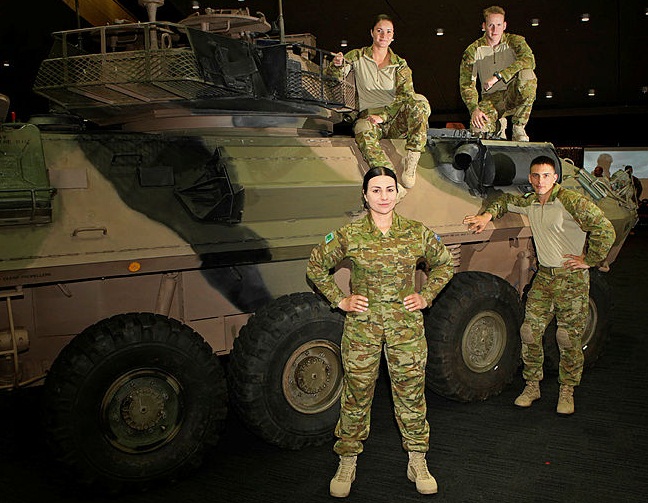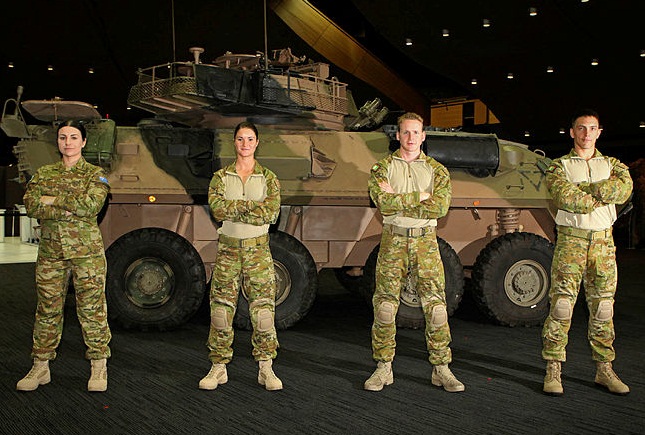The process to obtain licences, produce and distribute the new uniforms has taken years, but the roll-out will begin early in the new year.
“It’s always a really long process — it’s taken about five-to-six years to develop the new uniforms,” said Alice Barlin, senior technical advisor at the recently restructured Defence Materiel Organisation, the agency responsible not only for procurement of uniforms but also equipment such as aircraft, ships and vehicles.
Labelled the Australian multi-camouflage uniform, the new outfit will replace the so-called “disruptive pattern” camouflage uniform and is said to be more effective in combat.

“The old uniform has been in service since the early 1990s and the soldiers needed an update,” added Ms Barlin. “Up until 10 years ago we weren’t really going on operations; it was more test and trial situations. [But] after going to Afghanistan and going on operations the soldiers realised the uniform that they had wasn’t really what they needed.”
She said the new uniforms were more comfortable and would bring the Australian Defence Force up to date with its defence partners.
“This is supposed to be a more high-tech camouflage. We want it to be up there and be up to date with current technologies and visuals,” Ms Barlin continued.
“Basically, by looking at what other countries were using for operations and how it was impacting on their work and then how ours compared – we realised ours could be improved as it was quite old.”
The new pattern and cut has been obtained from Crye Precision, a US company producing a range of products for American troops.
Colonel Sean Hoffmann, systems project officer at the ADF’s land systems division, explained: “The Army purchased two licences [from Crye Precision] for several million dollars — one, so we could copy their design: cut, make and trim. Another [reason] so we could use our own unique pattern.”
The pattern contains a mixture of six colours — five from the original camouflage uniform and an extra colour, which was chosen by Army headquarters after intensive tests.
“After going to Afghanistan and going on operations the soldiers realised the uniform that they had wasn’t really what they needed.” —Alice Barlin, senior technical advisor, Defence Materiel Organisation
“The colours on the new uniform are colours which are supposed to be Australian vegetation colours or things that work here in the jungle and essentially in desert environments,” said Ms Barlin.
“So, we have used those colours to put into this new print and added an extra colour.
“They did lots of visuals and printed up lots of samples and looked at [the new colour] and assessed it for neon infrared and looked at it against current uniforms. Then Army headquarters had their say.”
The two new uniforms have been made for combat and barracks situations. But while both can be used in combat the barracks kit, known as the field uniform, is only for use in military bases.
“The combat uniform is the ideal uniform for combat environments but it is really expensive and quite technical. There are a lot of pockets on it, so it becomes quite heavy and quite warm,” said Ms Barlin.
“The field uniform is simplified: you don’t need all those pockets and the fancy knee pads in most environments. So, we made a simplified version that can be given to everyone as more of a day-to-day uniform.”
There are five key clothing items, including a general purpose jacket, which is similar to a hunting jacket.
“. . . everything that is used to make the uniform is made in Australia.” — Alice Barlin, Defence Materiel Organisation
“It’s waterproof and has removable lining to keep soldiers warm,” Ms Barlin explained. “Then there’s the combat shirt, which is similar to a sweatshirt, so it works better with body armour and any other kit the soldiers wear, while the field shirt is fitted with multiple pockets.
“Then there are the pants: the combat pant is fitted with multiple pockets but the field pant has fewer.”
There are also new thermal undergarments, and boots that are lighter and dry quicker.
All of the Australian defence camouflage uniforms must be made in Australia, which means they are “made in Australia, printed in Australia, weaved in Australia, dyed, everything that is used to make the uniform is made in Australia,” added Ms Barlin. “That’s a requirement from the [Defence] Minister. We are working with Australian Defence Apparel and the WorkWear Group, both situated in Victoria.”
Each Australian soldier will receive six of the new uniforms, three of each kit, at a cost of $1200.

The rollout, which is expected to take more than four years to complete, starts at the beginning of next year with combat troops in Afghanistan, Iraq, Qatar, Bahrain, South Sudan, Sinai and Lebanon the first to receive the new gear. Soldiers posted overseas in representational positions will follow, along with headquarters 1st Division based in Brisbane, according to Colonel Hoffman.
The rollout will then continue with soldiers in Darwin, followed by those in Townsville, Brisbane and Melbourne. All of the new uniforms are expected to be handed out by July 2020.